

Future of AI & Longevity. What if we could generate novel molecules to target any disease, overnight, ready for clinical trials?
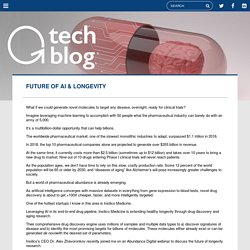
Imagine leveraging machine learning to accomplish with 50 people what the pharmaceutical industry can barely do with an army of 5,000. It’s a multibillion-dollar opportunity that can help billions. The worldwide pharmaceutical market, one of the slowest monolithic industries to adapt, surpassed $1.1 trillion in 2016. In 2018, the top 10 pharmaceutical companies alone are projected to generate over $355 billion in revenue. At the same time, it currently costs more than $2.5 billion (sometimes up to $12 billion) and takes over 10 years to bring a new drug to market. Researchers Just Got Funding to Grow a Neural Network in a Petri Dish. Will the computers of the future be built in factories as they are today, or will they be grown in labs like cell cultures?

That’s the question posed by an interdisciplinary team of biologists and computer engineers who won a $500,000 grant this week from the National Science Foundation. The researchers’ plan: to develop a computer made out of living cells and program it to perform computational tasks. Details about the upcoming project are scant. The grant winners say they will use living cells (they haven’t said what type) to construct a neural network.
Scientists Are Developing a Unique Identifier for Your Brain. Les neurosciences pour booster l’intelligence artificielle ? - Transhumanisme : Association Française Transhumaniste. Could You Transfer Your Consciousness To Another Body? — AsapSCIENCE. If you've been keeping up with Westworld, HBO's sci-fi show about artificial intelligence gaining consciousness, then you may be wondering: could we transplant our own minds?
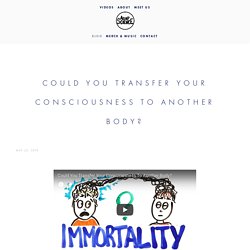
Is there a way we could become immortal after our bodies are defeated by aging? First, we need to understand how memories are stored. Your brain is a three-pound lump of fatty tissue that contains about 86 billion brain cells called neurons. By passing electricity or chemicals between them, neurons can send signals to each other. Scientists Construct Biocomputer Made From Living Human Cells. “Computer” may commonly mean an electronic device that processes a lot of complex information, but it’s worth remembering that the etymology of the word stems from the mid-17th century.
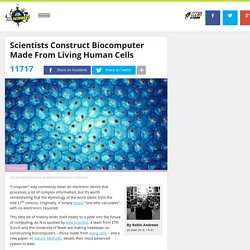
Originally, it simply meant “one who calculates”, with no electronics required. This little bit of history lends itself neatly to a peek into the future of computing. As first spotted by New Scientist, a team from ETH Zurich and the University of Basel are making headways on constructing biocomputers – those made from living cells – and a new paper, in Nature Methods, details their most advanced system to date. Using nine different cell populations assembled into 3D cultures, the team of synthetic biologists has managed to get them to behave like a very simple electronic computational circuit. Take out the electrical wiring and signaling, and replace them with chemical inputs, and you’ve got a living computer that responds to incoming data and can process it using rudimentary logic gates AND, NOT, and OR. Demain, un ordinateur inspiré de notre cerveau? Biocomputers Made From Cells Can Now Handle More Complex Logic. This Unbelievable Research on Human Hibernation Could Get Us to Mars.
'Biological Teleportation' Edges Closer With Craig Venter's Digital-to-Biological Converter. Is There a Multidimensional Mathematical World Hidden in the Brain’s Computation? Two thousand years ago, the ancient Greeks looked into the night sky and saw geometric shapes emerge among the stars: a hunter, a lion, a water vase.

In a way, they used these constellations to make sense of the random scattering of stars in the fabric of the universe. By translating astronomy into shapes, they found a way to seek order and meaning in a highly complex system. Des scientifiques ont amélioré la mémoire humaine avec un implant cérébral pour la toute première fois. Quelques nouveautés en « computation biologique » Ils ont transplanté la tête d’un donneur sur le corps d’un receveur, tous deux décédés. Achieving Viable Mind Uploading via Our Understanding of Brain Lateralization — Gray Scott.
Let me first make it clear that I'm writing this under the presumed notion that consciousness (and thus self-awareness) is a byproduct of a complex, interconnected brain and its synaptic wiring, i.e. it's not a separate entity in and of itself that operates outside of the brain's wetware.
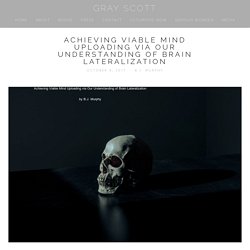
Having said that, the subject of mind uploading is a fascinating (and, at times, infuriating) topic that has sparked numerous research and debates over the last several decades. For those whose mindset infers that our sense of self is that of which in tandem with the notion of a "soul," mind uploading is a highly feasible prospect for potential post-human development. ?articles. Cp 170919 le premier nano neurone artificiel capable de reconnaissance vocale voit le jour. Creating Superwoman (and man): Who benefits from human enhancement? INSIS - Un neurone artificiel mille fois plus économe en énergie qu’un neurone biologique. Et si nos technologies devenaient organiques ? Un transhumanisme biologique est possible - Transhumanisme : Association Française Transhumaniste. Scientists turn mammalian cells into complex biocomputers. Computer hardware is getting a softer side.
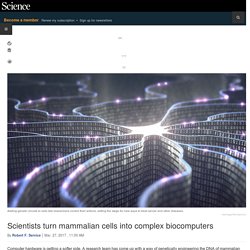
A research team has come up with a way of genetically engineering the DNA of mammalian cells to carry out complex computations, in effect turning the cells into biocomputers. The group hasn’t put those modified cells to work in useful ways yet, but down the road researchers hope the new programming techniques will help improve everything from cancer therapy to on-demand tissues that can replace worn-out body parts. Les ordinateurs ADN qui "s'auto-augmentent" vont tout changer. The Brain Tech to Merge Humans and AI Is Already Being Developed.
Are you scared of artificial intelligence (AI)?

Do you believe the warnings from folks like Prof. Stephen Hawking, Elon Musk and others? Is AI the greatest tool humanity will ever create, or are we “summoning the demon”? To quote the head of AI at Singularity University, Neil Jacobstein, “It’s not artificial intelligence I’m worried about, it’s human stupidity.” In a recent Abundance 360 webinar, I interviewed Bryan Johnson, the founder of a new company called Kernel which he seeded with $100 million.
It's Alive! Artificial-Life Worm Wiggles on Its Own. A worm wiggles.

It’s a process as old as time, but there’s a twist: This worm is a bit of open-source software that encodes biological data gleaned from decades of scientific study into the nematode C. elegans. The parameters are programmed, but the worm acted on its own. Will We Ever Be Able To Bring Cryogenically Frozen Corpses Back To Life? A Cryobiologist Explains. A teenager who tragically died of cancer recently has become the latest among a tiny but growing number of people to be cryogenically frozen after death.
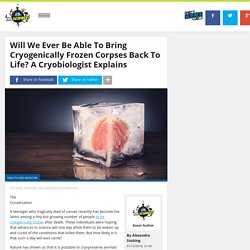
These individuals were hoping that advances in science will one day allow them to be woken up and cured of the conditions that killed them. But how likely is it that such a day will ever come? Nature has shown us that it is possible to cryopreserve animals like reptiles, amphibians, worms and insects. Nematode worms trained to recognise certain smells retain this memory after being frozen. ?articles. Researchers swap microscopy for RNA sequencing to track neural paths in the mouse brain.
FOLLOW THE mRNA: To determine where in the mouse brain individual neurons have axon terminals, researchers inject a library of viral vectors in the vicinity of cell bodies. The viruses contain plasmids each encoding a unique RNA barcode and a presynaptic protein called MAPP-nλ that will shuttle the barcoded mRNA to the ends of the axon. Typically, each cell takes up only one virus, giving that cell an RNA identifier. Biohybrid Robots Built From Living Tissue Start To Take Shape.
Think of a traditional robot and you probably imagine something made from metal and plastic. Such “nuts-and-bolts” robots are made of hard materials. As robots take on more roles beyond the lab, such rigid systems can present safety risks to the people they interact with. Les promesses du contrôle quantique. CRISPR-Enabled Bacteria Transformed Into Self-Replicating Biological Hard Drive. Silicon-based memory storage is reaching an impasse.
Like batteries, the technology hasn’t evolved very much over the last few decades, apart from getting smaller and more powerful, and there’s only so small we can get before the devices will stop working. With this in mind, researchers around the world have recently demonstrated that the future of memory may be in biology, not technology. Just this year, one team demonstrated how the whole of human history could be stored on a drop of DNA. Revolutionary Brain Implant Restores Hand Movement In Quadriplegic Patient. For many, paralysis or limb loss is a lifelong burden, and scientists across the world have been working around the clock to restore movement to these unfortunate few. Now, a new Nature study showcases what is not just a step but a leap forward in medical science. A young man, who became a quadriplegic during a diving accident, is today able to grasp objects and even play video games using his own hand and fingers, after a novel device was surgically inserted into his brain.
This Amazing Computer Chip Is Made of Live Brain Cells. A few years ago, researchers from Germany and Japan were able to simulate one percent of human brain activity for a single second. It took the processing power of one of the world’s most powerful supercomputers to make that happen. Hands down, the human brain is by far the most powerful, energy efficient computer ever created. So what if we could harness the power of the human brain by using actual brain cells to power the next generation of computers? As crazy as it sounds, that’s exactly what neuroscientist Osh Agabi is building. Koniku, Agabi’s startup, has developed a prototype 64-neuron silicon chip. Scientists 3D Print Human-Scale, Living Tissues. A Whole Rabbit Brain Has Been Cryogenically Preserved. NSI mondada. Scientists Discover "Intelligence" Genes That Code For Cognitive Ability.
Researchers have figured out how to store the entire Internet in a test tube. DNA to play an essential role in the future of Computers? - Labiotech.eu. Human Brain Grown In A Lab Could Be Most Complete Yet. Bacterial “Brain” Could Control Robots. Animal Brains Networked Into Organic Computer ‘Brainet’ - Singularity HUB. 6 Things the Digital Revolution already Disrupted in the Biotech Industry - Labiotech.eu. Angela Belcher : Utiliser la nature pour faire pousser des batteries. Could You Transfer Your Consciousness To Another Body? 20 billion nanoparticles talk to the brain using electricity - health - 08 June 2015. Mputer independently solves 120-year-old biological mystery.
Loi du retour accéléré : la théorie vertigineuse du futurologue de Google qui n’a jamais eu tort. Scientists Create Biodegradable Computer Chips. Layered "Neurons" Help Robot Learn Without Pre-programmingTrending. Drug Could Rejuvenate Aging Brain And Muscle Tissue. Closer to AI: Electronic Long-Term Memory Cells Mirror Human BrainTrending. Ordinateur à ADN. Protein-Hoarding Cells Live Longer with Organizer’s Help. Broad Institute of MIT and Harvard. Xeroxed gene may have paved the way for large human brain. DNA Hard Drive Could Store Data For Millions Of Years. The paths to immortality - Album on Imgur. Scientists Put A Worm's Mind Into A Robot's Body.
MIT: Synthetic DNA Can Be Used as Ink for Nanoscale 3D Printers.